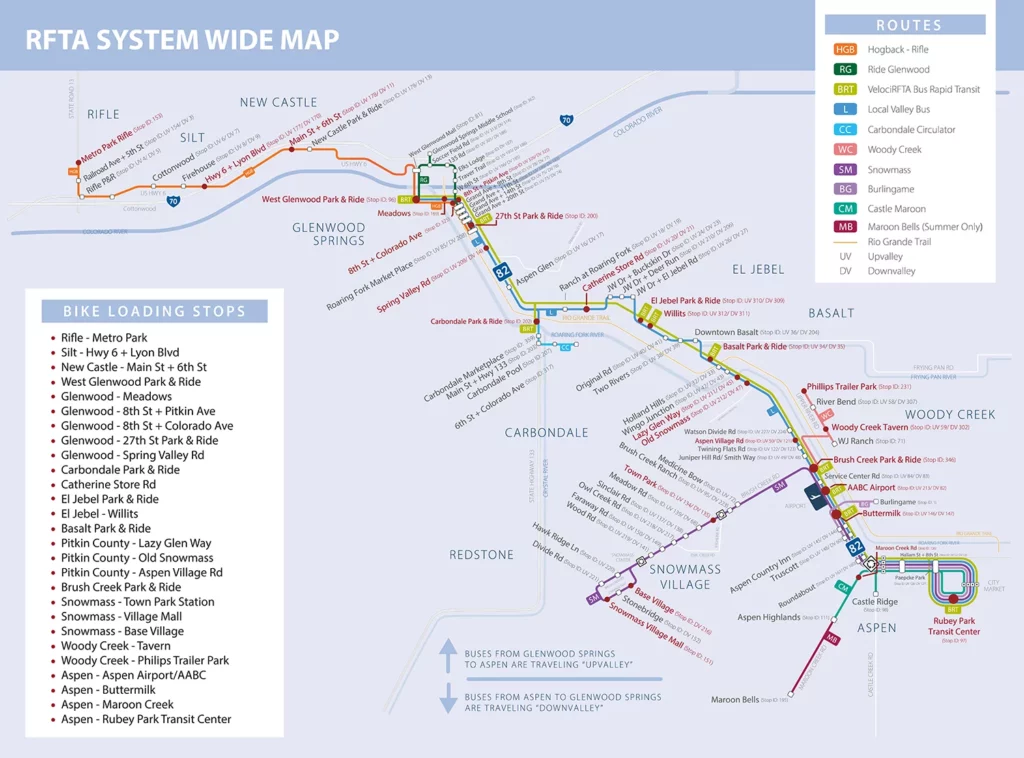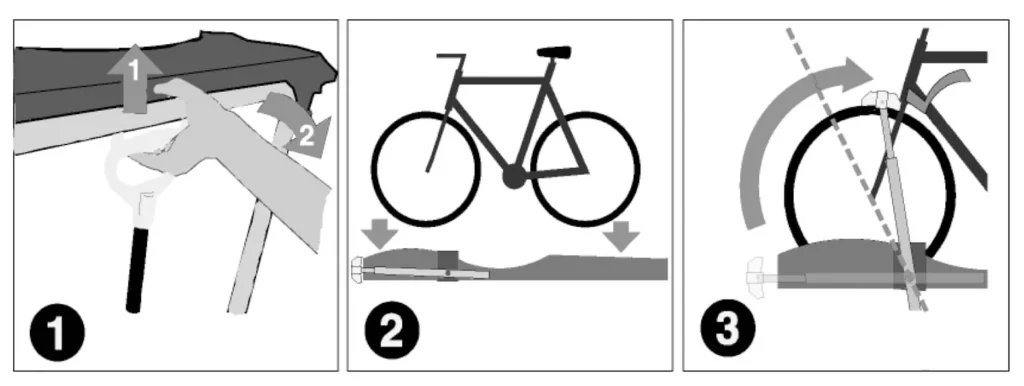BIKE & RIDE
RFTA provides bicycle racks on its valley fleet, allowing cyclists to ride the bus with their bikes between Aspen and Rifle, and points in between. All of RFTA’s valley buses have front-load racks. It is a first-come, first-served system. If the racks are full, you will need to lock up your bike at the stop, pedal to your destination, or wait for the next bus. Only people capable of loading and unloading their own bikes will be allowed to use the bike racks, unless accompanied by an adult who is capable of assisting. The driver is not in a position to assist. Please be sure to always carry a bike lock in case the bus bike rack is full and there is not another bus coming before the close of bike loading hours.
BIKE LOADING FROM MID-APRIL THROUGH LABOR DAY: 6:00AM TO 7:30PM
No Bike loading Fees
RFTA has eliminated the $2 bike fare to increase accessibility for our riders. This may increase bike loading traffic and bike and ride passengers may experience longer wait times to load their bikes. Bikes are loaded on a first-come, first-served basis. If the racks are full, you will need to lock up your bike at the stop, pedal to your destination, or wait for the next bus.
BIKE LOADING HOURS & DATES
Bike tires and spokes block headlights. Therefore, bikes are allowed to be loaded only during the following times:
FROM MID-APRIL THROUGH LABOR DAY: 6:00AM TO 7:30PM
FROM THE DAY AFTER LABOR DAY THROUGH THE LAST SATURDAY IN OCTOBER: 7:00AM TO 6:00PM
FROM THE LAST SUNDAY IN OCTOBER THROUGH MID-NOVEMBER: 7:00AM TO 4:30PM
NO BIKE LOADING DURING THE WINTER SEASON: LATE NOVEMBER TO EARLY APRIL
THERE IS NO FEE TO LOAD BIKES ON RFTA BUS BIKE RACKS.
BIKE LOADING BUS STOPS
Bike loading and unloading is limited to the designated RFTA stops listed below.
This is to ensure the safest and easiest transition for passengers, surrounding traffic and bus operators.
- Rife – Metro Park
- Silt – Hwy 6 + Lyon Blvd
- New Castle – Main St + 6th St
- West Glenwood Park & Ride
- Glenwood – Meadows
- Glenwood – 8th St + Pitkin Ave
- Glenwood – 8th St + Colorado Ave
- Glenwood – 27th Street
- Glenwood – Spring Valley Rd
- Carbondale Park & Ride
- Catherine Store Rd
- El Jebel Park & Ride
- El Jebel – Willits
- Basalt Park & Ride
- Pitkin County – Lazy Glen Way
- Pitkin County – Old Snowmass
- Pitkin County – Aspen Village
- Brush Creek Park & Ride
- Snowmass – Town Park Station
- Snowmass – Village Mall
- Snowmass – Base Village
- Woody Creek – Tavern
- Woody Creek – Philips Trailer Park
- Aspen – Buttermilk
- Aspen – Aspen Airport/AABC
- Aspen – Maroon Creek
- Aspen – Rubey Park Transit Center
HOW TO LOAD YOUR BIKE
RFTA’s buses are equipped with bike racks on the front that can hold two/three bikes. Bike loading is a first-come, first-served system. If the racks are full, you will need to lock up your bike at the stop, pedal to your destination, or wait for the next bus.
Prepare your bike for loading. Remove water bottles, pumps and other loose items that could fall off while the bus is in motion.
- Wait for the bus to come to a complete stop, approach the front of the bus, squeeze the handle to unlock and lower the rack.
- Lift your bike onto the bike rack, fitting wheels into proper wheel slots. The front wheel slot is clearly labeled.
- Raise the support arm over the front tire. Many bikes will sit in the wheel well without the use of the support arm, but the rack must not be used without the support arm.
Bikes with especially thin rims and tires will sway back and forth without its use. The Support Arm needs to be raised so that the hook rests beyond the highest point of the tire closest to the frame.
Unloading Bikes
Inform your driver that you will be unloading and safely remove your bike from the rack. Please return the bike rack to its original position if empty.
BIKE LOADING VIDEO
BIKE LOADING TIPS & RULES
- E-Bikes: are allowed on bike racks however they must weigh under 75 pounds.
- Not Allowed: Bicycles with child carriers or panniers, Bike trailers or Burleys, and Xtra-cycle cargo bikes are not allowed to be loaded as they are too heavy and bulky for the racks.
- Rack Ready Bike: Before the bus arrives, prepare your bike for loading by removing water bottles, pumps, baskets, or any loose items that might fall off.
- Full Rack: If the rack is full, please wait for the next bus.
- Loading: You are responsible for loading, securing, and unloading your bicycle from the rack.
- Alert Bus Driver: Direct the driver’s attention before you load or unload your bike to make sure no one is harmed.
- Traffic: Do not step into traffic while loading or unloading your bike. Load your bike from the curb. Also, do not cross the street in front of the bus – passing traffic cannot see you coming around the bus.
- Bicycle Park and Ride: Bicycle parking is available at many of RFTA’s bus stops including: Brush Creek Intercept Lot, Aspen Village, Old Snowmass, Basalt Park & Ride, El Jebel Park & Ride, and Carbondale Park & Ride. It’s a good idea to have a bike lock with you, in case the rack on the bus is full.
- Children: Only people capable of loading and unloading their own bikes will be allowed to use the bike racks, unless accompanied by an adult who is capable of assisting. The driver is not in a position to assist.
- Exiting: Use the front door when leaving the bus and notify the driver that you will be unloading your bicycle.
- Empty Rack: Move the empty rack into the upright position.
- Problems: If you notice any problems with a rack, alert the bus driver and wait for the next bus—it’s best for everyone’s safety and the safety of your bike.
- Folding bikes and small scooters that are completely folded up and not blocking bus isles are allowed on buses.
- Do not lock your bike to the rack.
- No bikes allowed inside of bus.
RFTA is not responsible for bikes placed on racks.

